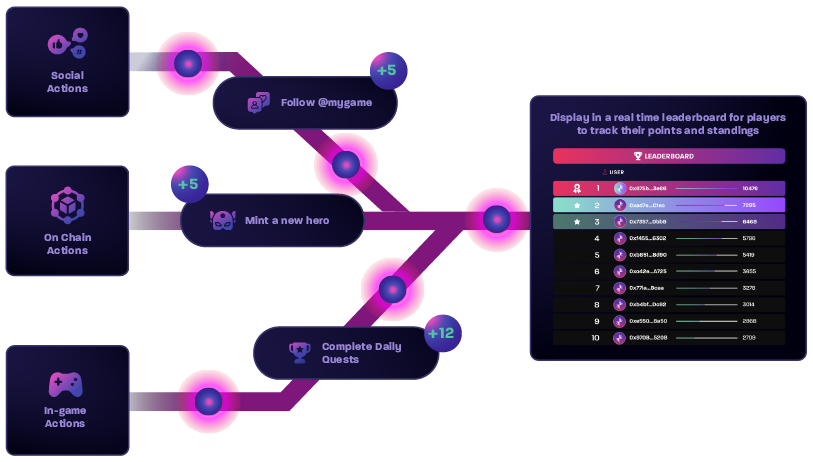Helika Engage
Web 3 questing platform with robust logic engine.
Summary
Helika Engage transforms in-game, on-chain, and social player data into a dynamic action engine that drives engagement, retention, and revenue for game studios. By handling end-to-end game engagement, Helika Engage allows you to focus on what you do best: building great games!
This powerful system triggers programmatic logic and applies downstream actions such as loyalty and reward systems, email marketing flows, play-to-airdrop campaigns, and other meta-features like quest and battle pass systems.

Value
⭐ Centralized Engagement Management: Track and manage player engagement across all channels—game, on-chain, and social—in one white-labeled hub, complete with campaign progress tracking and points-based leaderboards.
⭐ Detailed Customization: Use Helika Engage’s no-code editor and our white glove services to build complex engagement systems like quests, battle passes, and play-to-airdrop campaigns; tailored to your game’s unique needs and gameplay loops.
⭐Data-Driven Insights: Integrate with Helika Analytics to gain deep insights into campaign performance, optimize player engagement strategies, campaign performance and drive monetization.
Use Cases
Grow your community by providing a quest hub where players can interact and earn rewards based on their level of engagement.
Automate player engagement through a centralized hub, combining in-game telemetry, on-chain activities, and social media interactions to dynamically trigger campaigns and loyalty programs.
Optimize monetization strategies by analyzing player behavior across in-game, on-chain, and social channels, allowing for precise targeting of high-value player actions.
Enhance player retention by creating personalized experiences, leveraging Helika Engage’s programmatic logic to engage players across multiple touchpoints.
Applications
Play-to-Airdrop: Define bespoke scoring criteria to optimize for valuable player cohorts. Monitor player participation both in-game and off-game, and distribute rewards proportionally based on performance.
Quests and Achievements: Set up structured quests and achievements systems on the fly, track progress, and reward players dynamically.
Battle Passes: Customize battle passes based on in-game, on-chain, and social events. Tailor them to player archetypes and reduce development time by up to 90%.
Leaderboards: Create competitive environments through time-limited campaigns, with strategic points accrual and rewards like special skins, NFTs, and extra lives.
Helika Engage’s robust backend infrastructure adapts to each game’s unique behavioral loop, offering a versatile platform for live operations as a service. Whether you’re running user acquisition campaigns, optimizing onboarding, or driving monetization through targeted offers, Helika Engage has you covered.
Updated about 1 year ago